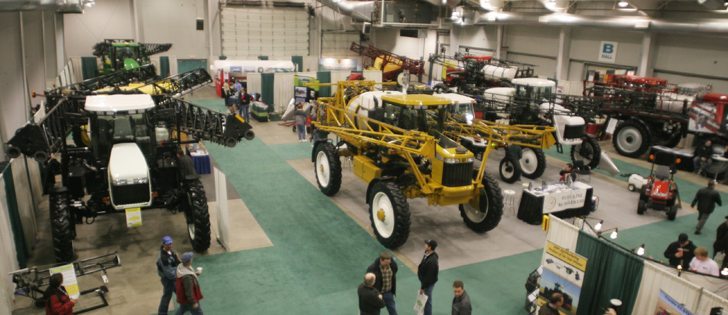A popular event | Saskatoon hosts four-day show, organizers hope to beat 2012 attendance record
Thirty years ago a group of individuals from the University of Saskatchewan and Saskatoon Prairieland Park Corp. thought it would be a good idea to put on a chemical, fertilizer and seed show.
After the inaugural Western Canadian Crop Production Show in January 1984, they decided it could become successful annual event given the right promotion.
That turned out to be an accurate forecast. The event has blossomed into a popular farmer gathering where a lot of business gets done.
The four-day show established a record attendance of 19,948 visitors last year, up from the previous five-year average of 14,964.
Read Also

New Alberta funding for program hopes to further unlock agritourism industry in province
Alberta Farm Fresh Producers Association is launching a new initiative thanks to $300,000 of provincial funding to bolster Alberta’s smaller scale family farms and agritourism sector.
Prairieland’s food service department expects to serve up 500 kilograms of roast beef at this year’s 30th anniversary event.
“It’s our largest show other than our summer fair — the Saskatoon Ex,” said Lori Cates, agricultural manager of Prairieland.
The success of the show is heavily dependent on the weather. A nasty blizzard cancelled an entire day of the event back in 2007 and sliced the four-day attendance total to 10,877 people.
Last year, the conditions were ideal.
“I mean we didn’t have any snow. We were just right around the zero (degrees Celsius) mark for all four days,” said Cates.
She said she thinks the show’s founders would have difficulty recognizing the modern event.
There were no attendance figures in 1984 because there was no charge for admission. But there were 80 exhibitors housed in the old Jubilee building.
The 2013 event will feature 327 exhibitors spread out among 20,439 sq. metres of trade show space.
“It takes every square inch of our buildings and all of our staff,” said Cates.
The cost of a typical booth has more than doubled to $750 from $300 in 1984. There will also be 12 outdoor trade show spaces at the 2013 event.
“It could be 30 below in January and people are still bringing their equipment here to put on display outside,” said Cates.
The four-day show generates considerable economic spinoff for the city.
“I know just from talking to the hotels I don’t think you can get a hotel room in the city that week,” she said.
“Going out for dinner that week is crazy.”
Agricultural input providers and equipment manufacturers and dealers appreciate that the show has stuck with its policy of allowing only exhibits related to crop production. Nobody is flogging mops, pots and pans or fudge.
That means the vast majority of people who come through the gates are active farmers there to conduct business.
“They’re here to talk about contracts and order fertilizer for next year and chemicals and to find out what the newest technology is,” said Cates.
“If you talk to any of the large equipment manufacturers that are at the show, I know the last few years that they’ve said they have nothing left to sell. So the equipment is moving.”
As part of the 30th anniversary of the show, Prairieland will be recognizing the 15 companies and institutions that have exhibited there for the past 30 years.
The trade show is held in conjunction with Crop Production Week, a series of commodity group meetings that take place at the Saskatoon Inn.
Crop Production Week co-ordinator Kevin Hursh said it’s hard to gauge how many farmers show up because they may attend a variety of commodity group meetings, which means they would be counted more than once.
“My gut feeling would be that there would be upwards of 2,000,” he said.
Ruth Klassen, banquet manager for the Saskatoon Inn, said it’s a tall order providing meals and coffee breaks for the 13 commodity groups hosting meetings at the hotel.
“Every single one of my meeting rooms is full every single day,” she said.
Each group wants their crop featured in the meals, so all of the dishes served at the SaskCanola meeting are made with canola oil and beans and lentils are incorporated into the salads at the pulse grower meeting.
Hursh said Crop Production Week has a tough time competing with the Crop Production Show on the other side of town.
“People tend to gravitate to the fun thing, which is to walk around and look at exhibits rather than the harder thing, which is to sit in a seat and try to let your mind follow what the speaker is talking about,” he said.
Those who tough it out at the meetings can gain valuable insights into the marketing side of the business and pick up hints on what to grow next year.
“The timing is excellent as people start putting their planning together,” he said.
There was a time when special crops companies would be out in full force with contracts in hand at the January meeting but that’s not the case anymore.
Hursh doesn’t know what anniversary this is for Crop Production Week. There is no clear date for when it morphed out of the University of Saskatchewan’s Farm and Home Week to become its own event.
The focus is more about the individual commodity groups rather than the umbrella event.
“We probably don’t spend as much time as we should celebrating it as an event,” said Hursh.
















